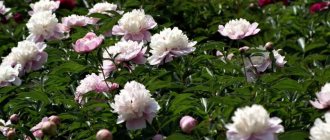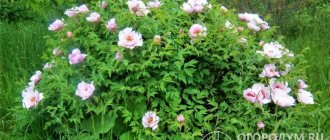The popularity of peonies in the landscape design of a summer cottage is second only to roses. It’s rare that an amateur gardener will refuse to plant peonies in the country house or in the garden, because in the spring, luxurious bushes with decorative foliage and lush large flowers become the main decoration of the site. In this article we will share the secrets of how to beautifully plant peonies on your site, we will talk about peonies in the garden, and landscape tricks that designers use to emphasize the beauty of these plants.
Features of the use of peonies in landscape design of a garden or plot
For a thoughtful design of a flower bed with peonies, it is recommended to make maximum use of the decorative properties of this plant. Peonies are valued not only for their bright and lush flowers, but also for the shape of the bush, leaves and the color of the petioles (some are bright red). Therefore, the gardener first needs to select several varieties, focusing on color, height, strength of stems and flowering time.
How to choose varieties of peonies for decorating a garden or plot
When choosing varieties of peonies, first of all, pay attention to the shades, shape and size of the flowers. Also, peonies in the landscape must have fairly strong stems so that they can reliably hold even a large number of flowers.
Therefore, to decorate the garden we can recommend the following varieties:
- White Sands – white with yellow stamens;
- My Love – white and soft pink;
- Karl Rosenfield – fuchsia;
- Feather Top – also fuchsia, with lilac tones;
- Old Faithful - red;
- John Howard Wiegell and Kevin - soft pink.
It is also worth considering the timing of flowering. For example, among the early flowering varieties, the following are especially attractive:
- Dutch Dwarf – pink, Japanese shape;
- Tiny Tim - a miniature bush in the shape of a cap;
- Merry Mayshine - a bush with graceful narrow leaves;
- Fairy Princess – large buds, rich pink;
- Eaglet is a variety with an interesting decorative bush in the shape of a vase and small but very bright flowers.
Recently, Ito hybrids are often used in landscape design: these are peonies obtained from crossing tree and herbaceous varieties:
- Garden Treasure – light yellow, quite large;
- Bartzella – terry, yellow;
- Viking Full Moon – light yellow with an orange core;
- Julia Rose – pink, light yellow, cream shade, grows in a compact bush.
Important! Some varieties are used in landscape design due to the beauty of their leaves - they have red stems and petioles that contrast well against a green background. These are, for example: Akron, Karl Rosenfield, Bev, Midnight Sun.
Garden decoration with peonies
Peonies are very bright, often large flowers growing on lush, compact or spreading bushes. They serve as a full-fledged decoration of the garden, so they can be used both in independent plantings and in compositions.
Here are some photos of the design of the area with peonies in the garden:
- Planting in rows along a path is a great way to define a path and also to separate one area of the garden from another.
- A hedge of peonies is one of the classic techniques in landscape design. It looks especially good against the backdrop of a well-groomed lawn - bright flowers harmonize with the green tint.
- Single planting against a background of bushes of approximately the same height.
- Central flower bed on an open lawn.
- Planting peonies next to a bench, gazebo and other seating areas is often used for decoration in landscape design.
Attention! Most varieties of peonies are light-loving. Therefore, they should be planted in open, bright spaces. However, weak shading is allowed - for example, from a bench or decorative bushes.
Design of a site with peonies
To decorate a site, flower growers strive to follow the classic rules of design, that is, correctly combine color shades, sizes and shapes of bushes. Since many peonies have attractive colors, they can be safely used in the landscape design of any flower bed and garden, for example:
- Classic round flower beds.
- A zigzag row of peonies is used in landscape design for zoning a garden.
- A unique hedge of different varieties of flowers.
- Flowers combined with perennial shrubs.
- Also, rocky flower beds are often used in landscape design, where these flowering shrubs also look appropriate.
Main characteristics
Caring for peonies after flowering - how to properly prepare the plant for winter
The peony of the peony family belongs to the genus of perennials. It can be bushy or herbaceous. It has a powerful, large rhizome that goes deep into the ground. Decorative foliage harmoniously complements the beautiful buds. The leaves can be of different shades from green to purple. Single lush flowers can reach a diameter of up to 25 cm. Depending on the variety, they can be spherical, double or pink. The complex multi-leaf fruits contain large, round, black seeds.
Interesting! Some varieties have quite decorative fruits.
The plant has high frost and drought resistance. The best place for its growth is in well-lit areas, protected from direct sunlight. It can grow and bloom profusely every season for 15 years. After this time, it does not die, but ceases to produce a lush color. Therefore, it is necessary to update the bush and move it to another place.
The buds bloom in late May or early June. There are varieties that bloom in the second half of summer. The average flowering period is one to three weeks.
What can you plant next to peonies?
You can plant both flowers and perennial green plants - herbaceous, coniferous and other crops - next to peonies in a flower bed, in a hedge or along paths. It is important to choose them so that they are harmoniously combined both in color and height.
What ornamental plants can be planted next to peonies?
Peonies go well with decorative perennials:
- With various types of hosta, against which the lush flowers will look especially beautiful.
- With various conifers (arborvita, dwarf spruce) - they look especially beautiful in rocky flowerbeds, rock gardens and on the coast of reservoirs.
- With herbaceous perennials that can be used in carpet plantings to decorate empty spaces in the garden.
Advice! When planting, it is important to take into account that shrubs or other large plants do not cast a strong shadow on the peonies - otherwise they will not bloom so luxuriantly.
Peonies harmonize very well with hosts, creating pleasant partial shade for them.
What flowers can be planted next to peonies?
These plants harmonize well with many flowers, for example:
- chrysanthemum;
- yellow daylily;
- delphinium;
- honeysuckle;
- astilbe;
- daisy;
- tulip;
- poppies
Advice! At the edge of the flowerbed you can plant annual flowers - for example, marigolds, cornflowers, coleus. They frame the flower row well, so they are often used in landscape design.
Is it possible to plant peonies next to trees?
It is not a good idea to plant peonies next to tall, lush and spreading trees, as they provide shade for a significant part of the day. This is, for example, apple tree, maple, pine and others. And even if a large tree does not shade the area (for example, a compact spruce), it will take away a significant part of the water and nutrients, which will have a bad effect on the development of the main crop.
Important! Fallen needles acidify the soil, and flowers generally prefer an alkaline environment.
Compatibility of peonies and thujas in landscape design
Thuja fits perfectly into almost any flower garden thanks to its beautiful greenery and graceful shape. Therefore, it is also used in planting with peonies, especially pink, bright yellow and red ones.
Compatibility of irises and peonies in landscape design
Irises are especially beautifully emphasized by white peonies. Both crops prefer bright sunlight, so they are suitable for placement in an open lawn.
The combination of light yellow and blue shades is one of the most harmonious
What not to plant next to peonies
It is not recommended to plant next to these flowers:
- Lush shrubs creating strong shade.
- Garden trees - they not only provide shade, but also take away moisture and nutrients.
- Any plants from the Buttercup family - they actively fill the area and compete with the main crop, sometimes inhibiting its development.
- Small flowers (pansies, petunias, marigolds), which, against the background of peonies, look bad in landscape design because they disappear from the general background.
Agricultural technology
The agricultural technology for herbaceous “Japanese” is the same as for all herbaceous peonies. This garden crop loves well-fertilized, moist soils. Therefore, manure, compost and fertile soil are immediately placed in large planting holes (60 x 60 cm in size). In the future, if there is a lack of nutrition, the bushes always give signals: the flowers become smaller, some buds do not bloom. Therefore, every season after flowering (during the formation of flower buds), a complex fertilizer for autumn is applied in liquid form at the rate of 50-70 g per bush. And, of course, you need to remember about watering, weeding, as well as pruning stems and timely hilling before winter. All this will lead to abundant and long-lasting flowering of peonies for many years.
Just as clothing fashion is constantly changing, so it is changing for peonies and their varieties.
The elusive charm of Japanese peonies and the sophisticated aesthetics of the East are increasingly attracting the attention of not only flower growers, but also breeders who continue to develop new varieties.
How to design flower beds with peonies
To beautifully design a flowerbed, it is important to consider:
- combination of colors (contrast of red against green, blue with yellow, bright with darker);
- tiering - large ones in the center, smaller ones in the foreground;
- general shape - for example, a circle can be visually highlighted with the help of low flowers or perennials (hostas, blue fescue, wild oats).
Rules for designing flower beds with peonies
If you are combining different varieties, it is better to plant them at the same time so that they grow synchronously. In addition, they must approximately match in height and bloom at the same time, otherwise the desired effect will not be achieved. Color combinations can be different - for example, red and white, yellow and red, pink and white.
It is better to choose bushes of the same height or plant tall ones in the center and low ones at the edges
Mixed flower beds with peonies in landscape design
These plants can be combined with different flowers, taking into account the color scheme and their height. They are planted in mixborders, hedges along the road, in various compositions (rock gardens, on the coast, rocky flowerbeds).
Mixborders decorate a flower garden well, so they are often used in landscape design.
Examples of flower beds and flower beds with peonies
When creating a flower bed, you can take the proven diagrams shown below as a basis.
Proper placement will allow you to achieve alternate lush flowering
1-delphinium, 2-peonies, 3-any lilac flowers, such as catmint, 4-azorella three-forked
Another option is to make a round flowerbed of perennial flowering plants:
- silver iris;
- phlox;
- peonies (pink and lilac varieties are better suited here);
- chrysanthemum;
- asters.
Reproduction
There are many ways to propagate tree peonies: by dividing the bush, cuttings, layering, grafting, from seeds. The first three methods are the simplest and most convenient for amateur gardeners, the fourth is effective, but requires special skills. Growing from seeds has its own characteristics.
Dividing the bush
For this propagation method, 5-6 year old bushes are used. The division process begins in the second half of August. How to properly divide a plant: shake off the soil from the roots, separate several parts in the area of the root collar. Each of the divisions should have 3-5 buds, from which shoots and roots will subsequently develop. Damaged areas are lubricated with a solution of potassium permanganate and sprinkled with powdered charcoal.
Rooting cuttings
When propagating using this method, short cuttings are cut from the semi-lignified stems of the tree peony, consisting of a piece of shoot and a leaf with a bud. The leaf part is shortened by 2 times to reduce the intensity of moisture evaporation. The cuttings are buried 1.5 cm in boxes filled with a substrate of equal amounts of sand and peat.
A film is stretched over the top to create an optimal microclimate. The soil is regularly sprayed and watered if necessary. By the end of September, the rooted shoots are transplanted from the box into pots and placed in a greenhouse. With the arrival of spring, sprouts appear from the buds and seedlings can be planted in open ground.
Reproduction by layering
The rooting process of cuttings takes two years. At the beginning of spring, the most developed shoots of the bush are carefully bent to the soil surface. At the point where the stem touches the ground, it is cut slightly, secured in this position with a spacer, and a layer of soil about 10 cm thick is poured on top.
Vaccination
For this propagation method, the rootstock is young herbaceous peony bushes. In early August, parts of the stem that have two buds are cut off from the specimen that needs to be propagated. At the bottom, the cuttings are cut, giving a wedge-shaped shape. A corresponding cut is also made on the root of the rootstock; these areas are tightly aligned and secured with several layers of plastic film.
The grafted bushes are placed horizontally in boxes with slightly damp sawdust. Peonies should be in the shade. A month later, the plants are planted in a greenhouse, placing the lower eyes at a depth of 5-7 cm. The soil surface is mulched to maintain soil moisture. After two years, the bushes are transplanted to a permanent place.
It will be useful to read:
Subtleties of growing and caring for Japanese quince When you hear the word “quince,” you immediately think of a large fruit tree and a hard, golden, hairy “apple.” And not at all...
Propagation by seeds
Tree Peony Seeds
Growing tree peony from seeds requires their stratification due to underdevelopment of the embryo. Long-term storage significantly reduces the quality of seed material, impairing its germination. When sowing in autumn, about 80% of the total amount germinates from the seeds of the current year. These plants begin to bloom after 4 or 5 years. Stratification ensures faster germination.
Description of the stages of the stratification process:
- The seeds are placed in sand with a humidity of 15% for a day. The temperature in the room is maintained variable - from 18 to 30 ° C. By the end of the day, the seed sprouts a root.
- At the second stage, the temperature is reduced to 5-10° C. Sand humidity should not exceed 10%. The procedure lasts until the first leaf appears.
To grow tree peonies from seeds, you can adapt a metal container with an electric lamp built into the lid. At the bottom of the improvised thermostat, small pots filled with sand and seeds are placed. Turning the lamp on and off allows you to create the required temperature regime. When the roots of the sprouts reach 1-2 cm in length, they are planted in a box with soil. The layer of soil above the seedling should be small. Plants are transplanted into a greenhouse in May, and into open ground in August.
A few ideas on how to plant peonies beautifully
And a few more ideas for using these bright shrubs in landscape design with photos for inspiration:
- Multi-tiered flower beds.
- Works along the house. In design they are used for zoning and forming visual boundaries of the entire flower garden.
- In single plantings. This technique in landscape design is used in cases where it is necessary to highlight the center of the garden or simply cover empty, ugly places.
- In the flowerbeds.
What flowers can't stand each other?
Let's take a look together at which house flowers can't stand being in the neighborhood and why this happens.
- Geranium and fern The compatibility of these plants is determined, first of all, by the requirements for growing conditions. ...
- Lemon and laurel Recent posts...
- Anthurium and orchid...
- Indoor rose and carnation
Interesting materials:
What are the objectives of the project? What is included in the residential part of the apartment? What does the security alarm system include? What does the project scope include? What does a three-phase circuit include? What is included in the company's assets? What is included in the total area of the building? What do engineering communications include? What tastes better, hot or cold smoking? What is tastier than pink salmon or sockeye salmon caviar?
Design tips
Each garden has its own characteristics, and truly beautiful flower arrangements can be created taking into account the advice of professional designers. Therefore, it is recommended to pay attention to some landscape tricks that will make peonies in the garden look truly impressive:
- The brightest, most luxurious flowers are used in single plantings in the center of the garden.
- When creating multi-tiered compositions, smaller plants are planted in the foreground, and the tallest plants are planted in the background.
- When selecting plants for a flower bed, color combinations are taken into account: for example, light yellow peonies look good against the background of yellow-green grass.
- Bright flowers look good against the lush green background of the lawn. If the bush is quite tall, it is better to form it on a trunk, that is, give it the shape of a tree by removing all the lower shoots.
- Along the edges of the path and in the hedge, it is advisable to use peonies of approximately the same height, as well as the same flowering period. It is optimal to plant them in the same year so that they grow synchronously.
Pinching buds
This technique is used when you want to grow huge cut flowers. You can show off these even at a flower exhibition. Pinching means removing the side buds on each flower stalk before they reach the size of a pea. This operation will allow the plant to put all its energy into the apical bud, and the remaining flower will be absolutely irresistible. In addition, the load on the peduncle will be less, and it will bend less.
Pinching will allow the plant to put all its energy into the apical bud.
If you do not pinch the side buds, the size of the flowers will be smaller, but the flowering time of the bush will be longer. By the way, you can almost always find ants on peony buds. They are attracted by the sweet secretion secreted by peony buds. They do not cause any harm to the plant.
The best varieties of red tree peonies for the Moscow region
'Vesuvian' pictured
'Vesuvius in the photo
'Vesuvian' - 'Vesuvius'. The flowers are large, double. Petals are crimson-red, numerous. Flowers with pale yellow anthers and short red filaments. The pistils are pale green, with purple stigmas. Bush up to 75 cm tall.
'Vladimir Novikov' in the photo
The flower is semi-double, 18-20 cm in diameter
'Vladimir Novikov' . The petals are red-beet-magenta, with an almost dark purple spot at the base, the edges of the petals are notched and corrugated. The staminodial disc is light with crimson veins, the filaments are crimson with bright yellow anthers. There are 5 or more pistils, the stigmas are pale pink. Bush 130-150 cm high, spreading. This tree peony, suitable for the Moscow region, has dark green leaves.
'Gauguin' pictured
'Gauguin' in the photo
'Gauguin' - 'Gauguin' . The flowers are large, crimson-red. Petals with dark crimson veins, along the edges with a magenta tint. The staminodial disc is dark pink. The stamens are large, with dark red stamen filaments. The height of the bush is up to 1.2 m.
'Coral' in the photo
Blooms in spring and again in mid-summer.
'Coral' . Hybrid variety. The flowers are single, the petals are red-purple, with a dark red spot at the base. The filaments are purple, the staminodial disc and stigma are pink. This is one of the best varieties of tree peonies with a height of more than 100 cm.
Peony 'Peter the Great' in the photo
The leaves are dark green and large.
'Peter the Great' . The flower is semi-double, 20 -25 cm in diameter, wide open. Petals are lilac-beet color with purple veins. Pistils from 9 to 13, stigmas bright crimson. The staminodial disc is poorly expressed. The filaments are pale lilac in color. Bush 130-150 cm high, spreading, multi-stemmed.
Peony 'Stefan' in the photo
The leaves are bright green.
'Stefan' . The flowers are single, 18-20 cm in diameter. The petals are crimson with lilac veins and a dark purple spot at the base. The staminodial disc is almost invisible. There are five or six carpels, pistils (5-6) with crimson stigmas, the staminate filaments at the base are crimson. Bush 90-100 cm high, small-stemmed, spreading.
Peony 'Vadim Tikhomirov' in the photo
The leaves are dark green.
Features of care
In order for peonies to delight with abundant and persistent flowering, they must be properly cared for. What basic rules for caring for flowers do gardeners advise you to pay attention to:
- Watering the bushes should be plentiful, especially during the development of buds. One bush should require 30 to 40 liters of water;
- Regular loosening of the soil around the bush is important. This way the peony tubers will be provided with the oxygen they need;
- The soil around the bush should not be allowed to become clogged with various weeds. They have a detrimental effect on the bushes, take away moisture and slow down the appearance of buds.
Another important point: to achieve large inflorescences, one, maximum two buds should be left on the stem. This rule applies to herbaceous plant varieties. Tree-like buds should not be touched.











